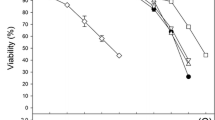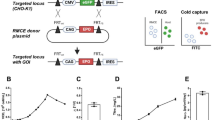Abstract
Dimethyl sulfoxide (DMSO) (1% v/v) stimulated stable transformed Chinese hamster ovary (CHO) cells to synthesize different recombinant proteins and repress their proliferation rate. The expressions of a fusion protein and β-galactosidase were increased 1.6- and 1.4-fold after adding DMSO. The expression of fusion protein was increased by up to 2.8-fold that of uninduced control by the simultaneous addition of DMSO and pentanoic acid. However, DMSO did not increase the production of the monoclonal antibody (immunoglobulin G) of three hybridoma cell lines (OKM1, OKT4 and HyGPD-YK-1-1), although it could inhibit the growth rates of the hybridoma.
Similar content being viewed by others
References
Campbell PL,Kulozik AE,Woodham JP,Jones RW (1990) Induction by HMBA and DMSO of genes introduced into mouse erythroleukemia and other cell lines by transient transfection. Genes Develop. 4: 1252-1266.
Cherlet M,Marc A (2000) Stimulation of monoclonal antibody production of hybridoma cells by butyrate: evaluation of a feeding strategy and characterization of cell behavior. Cytotechnology 32: 17-29.
Lamotte D,Buckberry L,Monaco L,Soria M,Jenkins N,Engasser JM,Marc A (1999) Sodium butyrate increases the production of β-2,6-sialylation of recombinant interferon-gamma expressed by β-2,6-sialyltransferase engineered CHO cells. Cytotechnology 29: 55-64.
Liu CH,Chu IM,Hwang SM (2001) Pentanoic acid, a novel protein synthesis stimulant for Chinese Hamster Ovary (CHO) cells. J. Biosci. Bioeng. 91: 71-75.
Marks PA,Richon VM,Kiyokawa H,Rifkind RA (1994) Inducing differentiation of transformed cells with hybrid polar compounds: a cell cycle-dependent process. Proc. Natl. Acad. Sci. USA 91: 10251-10254.
Melkonyan H,Sorg C,Klempt M (1996) Electroporation efficiency in mammalian cells is increased by dimethyl sulfoxide (DMSO). Nucl. Acids Res. 24: 4356-4357.
Partington GA,Patient RK (1999) Phosphorylation of GATA-1 increases its DNA-binding affinity and is correlated with induction of human K562 erythroleukemia cells. Nucl. Acids Res. 27: 1168-1175.
Saito H,Kagawa T,Tada S,Tsunematsu S,Guevara FM,Watanabe T,Morizane T,Tsuchiya M (1992) Effect of dexamethasone, dimethylsulfoxide and sodium butyrate on a human hepatoma cell line PLC/PRF/5. Cancer Biochem. Biophys. 13: 75-84.
Seki J,Ikeda R,Hoshino H (1996) Dimethyl sulfoxide and related polar compounds enhance infection of human T cells with HIV-1 in vitro. Biochem. Biophys. Res. Commun. 227: 724-729.
Stratling WH (1976) Stimulation of transcription by polar organic compounds. Nucl. Acids Res. 3: 1203-1213.
Yoon SK,Ahn YH,Kwon IC,Han K,Song JY (1999) Influence of reducing agents on the secretion rate of recombinant erythropoietin from CHO cells. Biotechnol. Lett. 20: 101-104.
Author information
Authors and Affiliations
Rights and permissions
About this article
Cite this article
Liu, CH., Chu, IM. & Hwang, SM. Enhanced expression of various exogenous genes in recombinant Chinese hamster ovary cells in presence of dimethyl sulfoxide. Biotechnology Letters 23, 1641–1645 (2001). https://doi.org/10.1023/A:1012466112116
Issue Date:
DOI: https://doi.org/10.1023/A:1012466112116




